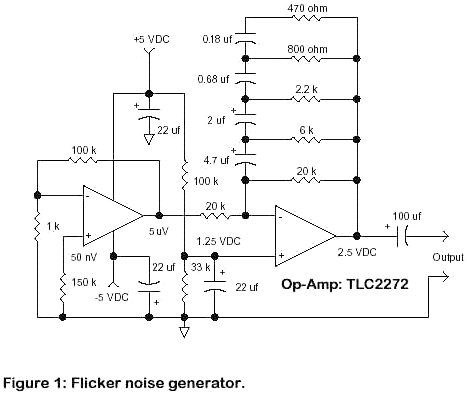

![]()
The circuit shown in fig. 1 is an implementation of a flicker noise generator described in NBS technical note #604, "Efficient Numerical and Analog Modeling of Flicker Noise Processes" by J.A. Barnes and Stephen Jarvis, Jr. With the values shown the circuit will give a 1/f noise slope from below one hertz to over four kilohertz. The circuit employs a TLC2272 op-amp although other high impedance, low noise op-amps will work. The amplifier must have low noise current since a farily high value resistor is used to generate the 50 nV white noise; choose an op-amp with noise voltage less than 15 nV/root-Hz and noise current less than 0.1 pA/root-Hz, both easily obtained with several modern op-amps. The capacitor values vary slightly from the calculated values in the referenced paper to simplify construction and the circuit includes bias to allow the use of polarized electrolytic capacitors. The electrolytic capacitors should be selected carefully since many aluminum electrolytics have poor tolerances.

Unlike circuits employing zeners, reverse-biased transistors, and other noisy devices, this circuit gives a predictable and repeatable output level. Bringing the first op-amp's output out through a 100uF capacitor in a similar manner to the second will yield a handy, precise 5 uV/root-Hz white noise covering the audio band that will serve as an excellent source for calibrating audio noise measurements. In order to bias this capacitor at about +2.5 volts you may wish to add about 30 megohms from +5 VDC to the positive input of the first op-amp. If you use a tantalum capacitor, bias is not necessary since tantalums can withstand zero bias. (F.Y.I.: Even a small reverse bias voltage up to about 10% of the rating is OK with tantalum capacitors.) A summing amplifier could be added to combine the white noise at the output of the first op-amp to the flicker noise at the output to simulate various noisy devices and systems. The two inputs to the summing amplifier would allow for independent adjustment of the white and flicker components.